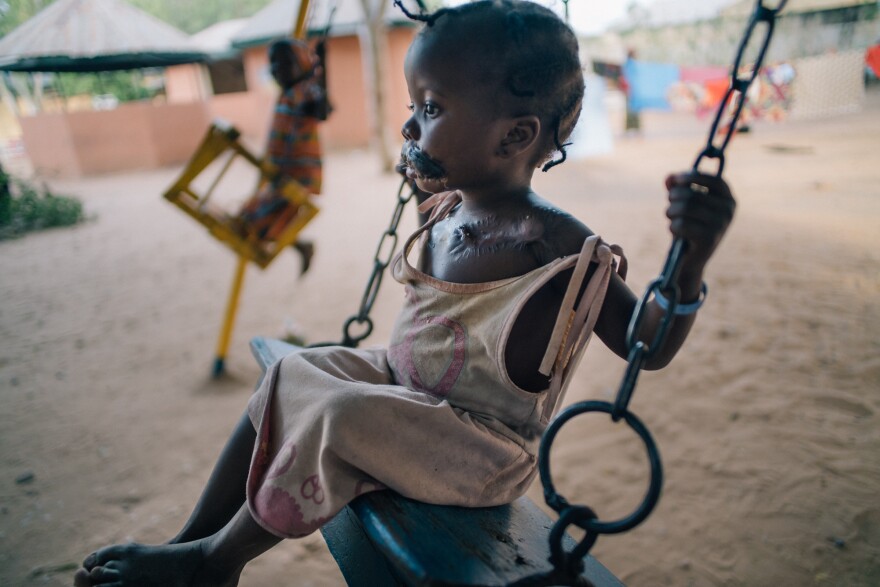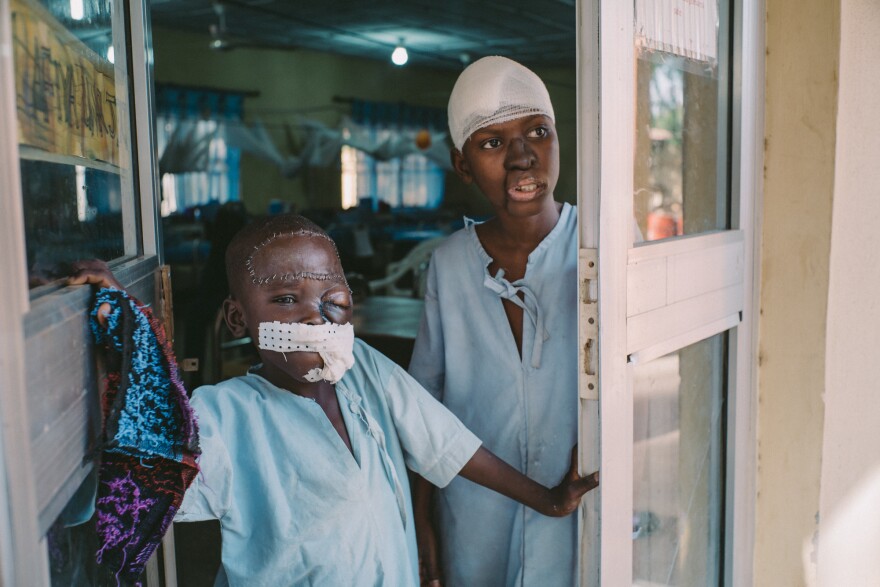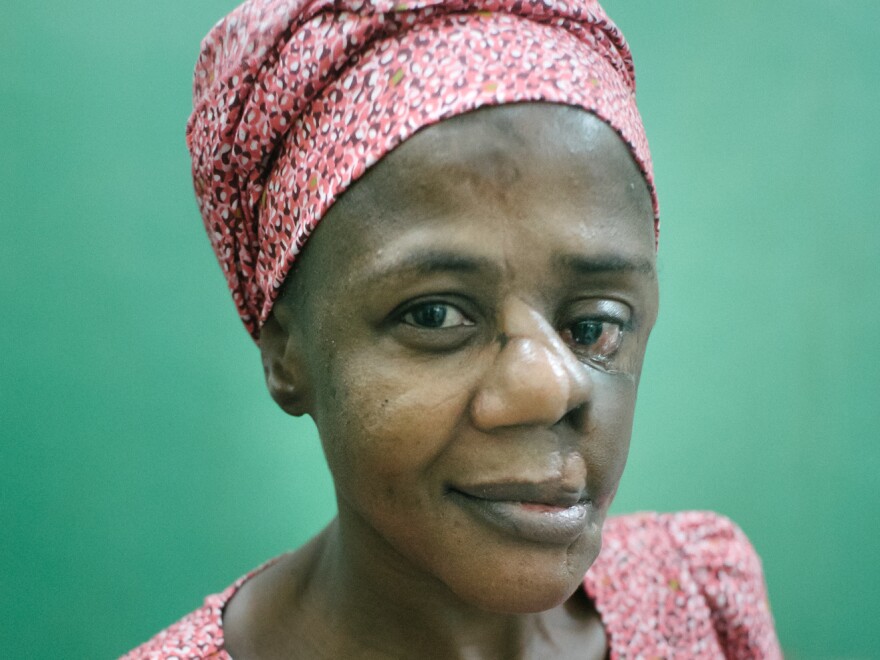It started out as malaria – or at least that's what her grandparents thought. But there was another devious infection lurking beneath the surface of her skin and inside her mouth.
Mulikat Okanlawon was a child, only 6 or 7 years old, when she contracted noma – a rare gangrenous infection that ate away at the flesh and bone in her face.
Compared to others who get noma, Mulikat was lucky. It almost always leads to death.
Those who survive are left with substantial facial disfiguration that requires repeated reconstructive plastic surgery to repair. That's why some global health workers call noma the "face of poverty."
A mysterious thousand-year-old ailment
The name noma comes from the Greek word "nomē" meaning "to devour" and despite cases of noma being recorded over 1,000 years ago, in the 21st century we still don't know a lot about it.
Researchers do know that noma primarily affects children between the ages of 2 to 6 in regions of extreme poverty, like parts of Africa and Asia, but it's unclear why children are more at risk.

And they know that noma is deadly – WHO estimates that 90% of patients die if they don't receive treatment.
But we still don't know exactly what causes noma. "We think it's mostly bacteria. But we're not really sure which ones," says Dr. Mark Sherlock, a health adviser with Doctors Without Borders who oversees their noma operations in Nigeria.
For reasons doctors don't yet understand, the bacteria in the mouth start to eat away at flesh and bone. "It's almost like that part of the body is dying," says Dr. Leila Srour, a pediatrician working with the organization Health Frontiers in Laos to fight noma. "It's a gangrenous infection. The disease spreads through the soft tissue and through the hard tissue and creates a hole. Then because it's an infection, it can get into the bloodstream. That's probably how these children die."
Not only do we not know exactly what causes noma, but we don't know how many children get it either. "Noma is a biological indicator of extreme poverty," says Srour. "Those children are most of the time born in places where their birth wasn't even recorded, and their death won't be either."
What we do know is based upon data from those who do make it to a hospital or by looking for survivors in remote places. The last time the World Health Organization (WHO) gave an estimate was in 1998: 140,000 new cases each year. There hasn't been an update since.
"The irony of noma is that when a country is able to count the victims of noma" – when it has developed a comprehensive way of keeping records – then the country has seen other improvements in public health and childhood health so "that the disease stops to exist," says Srour.
Mulikat's experience is a clear example of how a lack of basic resources can lead to dire consequences. She doesn't have a birth certificate; the Nigerian village in which she was born didn't record births. So she doesn't know exactly how old she is now, though her colleagues at Doctors Without Borders guess she's about 38.
She was also malnourished as a child. "The food they were giving us in the village ... there was not enough protein. You can see the traces of flies all around your food," she says.
Mulikat's circumstances allowed for noma – this life-threatening opportunistic infection – to take hold. If she had better food or been able to see a doctor when she first fell ill, it's likely she wouldn't have suffered the fate she did.
Simple antibiotics help — if they're available
Noma can be successfully treated in its early stages with routine and widely available antibiotics. Any basic health-care system with a knowledge of noma can treat patients easily. But therein lies the problem: Noma is found in places that don't have access to that basic level of care.
For patients in remote communities, the hospitals that can diagnose and treat noma are often far away.
Unfortunately by the time families recognize that an infected child needs medical attention, it might already be too late. "Not many actually get treatment in time," says Sherlock. "If you were to manage these patients early through simple antibiotics available all over the world, you will save lives."

Those few children who do survive are "left with this disfigurement and dysfunction. They may have great difficulty eating and speaking," says Srour. Then those survivors typically have to undergo repeated bouts of surgery to reconstruct the bone and tissue in their face.
This is exactly what happened to Mulikat. "In Sokoto I got my first successful plastic surgery [then had surgery] about five times before getting to this present stage," she says. Now Mulikat is able to engage in social situations instead of hiding herself away, like she did before the surgeries. Even though her face still bears the distinct scars of a noma survivor, she says, "I see myself as a human being like any other."
Mulikat received her follow-up care and surgeries at the Sokoto Noma Hospital free of charge. It's one of only a few hospitals in the world dedicated to treating noma survivors. An international group of doctors and surgeons travel to the hospital, volunteering to perform reconstructive surgery and other procedures that most noma patients would otherwise be unable to afford.
Even after surgery, survivors like Mulikat face considerable social challenges reintegrating into society. "My experience as a noma patient wasn't easy. It was terrible, there was a lot of limitation, a lot of stigma, I couldn't associate myself with people in the community." Some people are afraid the disease might be contagious – it's not – while others see the scars left from the disease and are repelled.
A campaign to get the world to pay heed
One of the major problems in the fight against noma is getting it recognized by international neglected tropical disease specialists. Unfortunately, Sherlock says that the international community doesn't pay much attention to noma — or even knows it exists. "I had never heard of noma until I first came across two teenage noma survivors in South Sudan in 2017," says the Irish doctor. "Despite me having a very privileged education in the U.K., I was not informed or knowledgeable at all about this disease."
One of the first steps to increasing awareness about noma is getting it onto the World Health Organization list of neglected tropical diseases (NTDs).
"Getting on to this list is no silver bullet," says Sherlock. "But what this list does is it makes the disease legitimate in the eyes of donors to fund further research on the disease, and it brings awareness."
"I'm very optimistic that if noma were included on the list that it could lead to the elimination of this disease," says Srour.
Both Sherlock and Srour hope that the day noma appears on the WHO Neglected Tropical Diseases list will come soon, potentially during one of WHO's NTD advisory group meetings this year. Indeed, major academic journals like PLOS Neglected Tropical Diseases have recently started considering noma as an NTD, which gives research on noma a higher profile platform for publication.
But getting onto the WHO list is only the beginning. "With noma, unfortunately, you're looking at much bigger structural challenges. You're looking at poverty, you're looking at the collapsing of health systems," says Sherlock. "Those are difficult factors to manage."
So there is much more to be done before substantial resources can be mobilized in the fight against noma, say the advocates. But in the meantime Doctors Without Borders is focusing on care for survivors in places like the Sokoto Noma Hospital, where Mulikat received her follow-up care and reconstructive surgeries.
For Mulikat, all those treatments and surgeries gave her a new lease on life. "After the treatment I began to admire myself and then went back to school," she says. "I'm really happy because where I was before is not where I am now."
She now works in the hospital as a health promoter: talking to other survivors who face the same difficult road to recovery as she did, guiding them through the difficulties of dealing with multiple surgeries and stigma from their community.
"I know that when there is life there is hope," says Mulikat. "The patients in the hospital see me, I talk to them and share my life experiences. Just by hearing from me they have hope."
Copyright 2023 NPR. To see more, visit https://www.npr.org.




